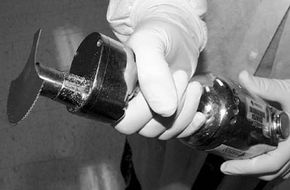Autopsy Procedure: Internal Examination
The internal examination starts with a large, deep, Y-shaped incision that is made from shoulder to shoulder meeting at the breast bone and extending all the way down to the pubic bone [source: Britannica]. When a woman is being examined, the Y-incision is curved around the bottom of the breasts before meeting at the breast bone.
The next step is to peel back the skin, muscle and soft tissue using a scalpel. Once this is done, the chest flap is pulled up over the face, exposing the ribcage and neck muscles. Two cuts are made on each side of the ribcage, and then the ribcage is pulled from the skeleton after dissecting the tissue behind it with a scalpel.
Advertisement
With the organs exposed, a series of cuts are made that detach the larynx, esophagus, various arteries and ligaments. Next, the medical examiner severs the organs' attachment to the spinal cord as well as the attachment to the bladder and rectum. Once this is done, the entire organ set can be pulled out in one piece and dissected for further investigation.
During this dissection, the various organs are examined and weighed and tissue samples are taken. These samples take the form of "slices" that can be easily viewed under a microscope. Major blood vessels are also bisected and examined [source: Waters, Stoppler].
The examiner opens the stomach and examines and weighs the contents. This can sometimes be helpful in figuring out the time of death (more on time of death later).
The examiner will then remove the body block from the back and put it behind the neck like a pillow, raising the head of the body so that it's easier to remove the brain.
The examiner makes a cut with a scalpel from behind one ear, across the forehead, to the other ear and around. The cut is divided, and the scalp is pulled away from the skull in two flaps. The front flap goes over the body's face and the rear flap over the back of the neck.
The skull is cut with an electric saw to create a "cap" that can be pried off, exposing the brain. When the cap is pulled off, the dura (the soft tissue membrane that covers the brain) remains attached to the bottom of the skull cap. The brain is now exposed. The brain's connection to the spinal cord and tentorium (a membrane that connects and covers the cerebellum and occipital lobes of the cerebrum) are severed, and the brain is easily lifted out of the skull for examination.
Throughout this whole process, the medical examiner is looking for evidence of trauma or other indications of the cause of death. The process varies based on the nature of the case and is incredibly detailed — the forensic pathologist has to adhere to an intricate, in-depth process to ensure the proper collection and documentation of evidence.
After the examination, the body has an open and empty chest cavity with butterflied chest flaps, the top of the skull is missing, and the skull flaps are pulled over the face and neck. To prepare the body for the funeral home:
- The organs are either put back into the body or incinerated.
- The chest flaps are closed and sewn back together.
- The skull cap is put back in place and held there by closing and sewing the scalp.
The funeral home is then contacted to pick up the deceased.
"An average autopsy case takes about four hours," Kiesel explains. "That's including all the paperwork. There is about a half an hour before and after the autopsy for doing the external examination, the dictation, the paperwork. The autopsy can take anywhere from one hour to two hours if it's an uncomplicated case. If it's a complicated case like a homicide ... it can take many hours — four to six hours."
"The medical examiner will then take all of the information that they've received from the autopsy exam, all of the information they've received from the investigation, and they will determine a cause of death and a manner of death," Kiesel adds.
In the next section, we will learn about the examination of wounds and injuries.
